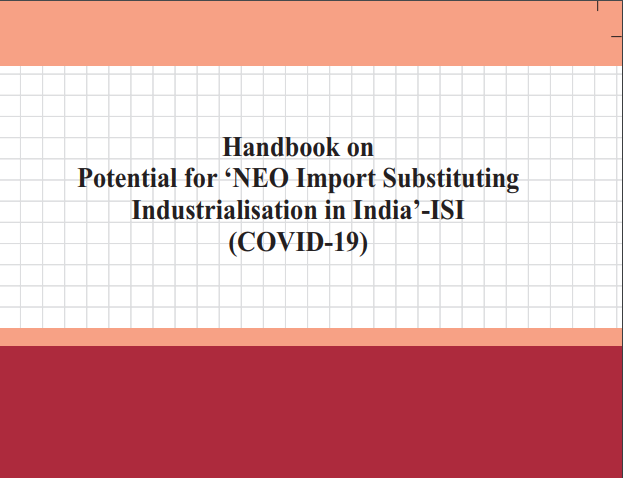Handbook on Potential for ‘NEO Import Substituting Industrialization in India’-ISI (COVID-19): ICAI
Handbook on Potential for ‘NEO Import Substituting Industrialization in India’-ISI (COVID-19)
Chapter-1 Introduction
The World is entering the new COVID-19 era of Sustainable Development Goals. These include poverty eradication, education for all, inclusive economic growth, full employment, reduced inequality, climate change mitigation, and sustainable use of the world’s ecosystems. Economic transformation is critical to make these socio-economic and environmental goals achievable and sustainable.
Economic transformation requires long-term investment to support the expansion of productive capacities, as well as infrastructure development that underpins industrial activities and reduces the bottlenecks. Rapid, transformative growth will also require, from the developing world, a more autonomous development strategy, in the light of the fragile world economic recovery and the uncertainty about developed country demand and capital as drivers of developing country growth.
Projections of the potential impact of the Covid-19 shock on economies around the World for the year 2020 vary widely. However, there is broad agreement that the global economy will contract given the sudden stoppage due to large swathes of activity and the resulting income loss in the manufacturing and services sectors across the world and most advanced countries like China, combined with the adverse effects on financial markets, consumption (through both income and wealth effects), investment confidence, international trade, and commodity prices.
Recently a series of stimulus packages unprecedented in both scale and scope have been announced by the major developed economies and China to extenuate the mounting economic damage and respond to the health crisis. Aside from financial injections to keep the banking and corporate balance sheets on relatively stable footing, the critical measures to avert contractions of economic activity include government spending (particularly on health care), extended unemployment benefits, and cash transfers.
Developing countries, however, face distinct pressures and constraints which make it significantly harder for them to enact effective stimulus without facing foreign exchange constraints. And as these countries do not issue International reserve currencies, they can only obtain them through exports or sales of their reserves. What are more, exports themselves require significant imports of equipment, intermediate goods, know-how, and financial business services? Finally, the financial turmoil from this crisis has already triggered sharp currency devaluations in developing countries, which makes servicing their debts and paying for necessary imports for their industrial activity will be more onerous.
Many developing countries were slowing down during the final quarter of the last financial year with several of them entering into a recession. However, the speed at which the economic shock to advanced economies has hit developing countries in many cases in advance of the health pandemic is dramatic, even in comparison to the 2008 Global financial crisis.
The economic fallout from the Covid-19 shock is on-going and increasingly difficult to predict but there are clear indications that things will get much worse for developing economies before they get better.
First, the full effects of the health crisis are yet to hit many developing countries, and we have yet to reach the “end of the beginning” of the economic crisis in the advanced economies. Following the collapse of Lehman Brothers in September 2008, the Global economy registered 5 consecutive quarters of negative growth, albeit at a decelerating rate after the second quarter of 2009; despite the massive stimulus packages now being implemented to prevent a long period of depression and may avert a recession in the global economy this year.
Second, many of the conditions that produced a sharp bounce back in developing countries after 2010 are no longer present or considerably weaker. China’s massive stimulus in 2009 and rapid return to double-digit growth had strong positive effects on demand for the exports of developing countries while the search for yield by Northern investors operating under the loose monetary policy adopted by leading Central Banks heightened their appetite for risk assets, producing a rapid rebound in capital inflows in emerging and other developing countries. Moreover, confidence in the developing world was boosted by expanding South-South trade and financial links that had begun before the crisis hit, encouraging the idea that developing countries had “decoupled” from the economic troubles of developed countries. These conditions are unlikely to be repeated this time around. In addition, weakening state capacity, diminishing fiscal space, and a rise in illicit financial flows over the past decade, place further constraints on the effective recovery strategies in many developing countries.
Third, the strong recovery in developing country trade that occurred in 2010 seems less likely this time. Even if the damage to global supply chains is not irreparable, as lead firms recover from the crisis, they will have to rethink their business model, including fewer links in these chains, and with more that are closer within the Country. Moreover, China has steadily diminished its dependence on external suppliers in its chains through an increase in domestically produced intermediate products. At the same time, there has been too little diversification of economic activity in many developing countries over the past decade with greater commodity dependence in many countries leaving them more exposed than ever to new shocks and disturbances.
Fourth, the current fall of commodity prices has started from a lower value compared to what happened in the GFC (Grazing Food Chain) when the world economy was at the peak of the “super commodity cycle” and appears to be broad-based. Commodity prices have been well off their post-recovery highs since the price slump in 2016 but it seems unlikely that there will be the same kind of pick up in prices seen between 2009 and early 2011 which was well ahead of the recovery in global output.
Fifth, new vulnerabilities have emerged that are likely to hold back growth. Emerging economies, in particular, have seen a rapid build-up of private debt in reserve currencies and increased penetration of their markets by nonresident investors, foreign banks, and other financial institutions, as well as allowing their own residents to invest more freely abroad. There has also been a strong shift in the ownership of Central Government debt, including public external debt, from official to private creditors and shadow-banking actors. These trends heighten developing countries’ external vulnerabilities and entail large transfers of resources to advanced economies through various financial channels. Moreover, the greater presence of foreigners in bond and equity markets has increased the potential instability of exchange rates and further exposed domestic financial markets to the vagaries of global risk appetite and liquidity conditions.
Finally, developing countries’ ability to build up international reserves as a buffer against macro-economic shocks has been weakening. In the aftermath of the global financial crisis, developing countries’ International reserves increased steeply, precisely in response to an evident need for “self-insurance” in a volatile global economic environment. However, since the onset of the commodity price downturn in 2012, reserve holdings, while still high by historical standards, have fluctuated widely, reflecting multiple pressures on developing countries’ ability to maintain high reserve holdings, such as commodity price downturns and growing debt and financial vulnerabilities. Given the massive expected impact of the Covid-19 crisis, reliance on such self-insurance is not an option, with reserves likely to be drained very fast.
The analysis of the impact of the Covid-19 shock has been mostly concentrated on China and advanced economies since they were initially more affected by the pandemic and account for three-quarters of the world output and have the monetary and fiscal policy space to respond. However, since two-thirds of the world population lives in the (remainder of the) developing world, the responses to the current shock must include dedicated actions for developing countries, at all income levels.
In general terms, there are three main transmission mechanisms or channels through which the Covid-19 shock can be expected to increase the financial pressures on developing economies over the coming months.
The first channel is the pressure on Government budgets from the public health crisis. The social distancing necessary to stop the contagion and it has already led to an economic shutdown in many developed and developing countries affecting the majority of the world’s population. A sharp, sudden fall in employment is already happening. While developed countries have the administrative capacity and (generally) the fiscal space to buttress their social protection systems and protect private incomes, in developing countries sharp contractions of incomes are all but inevitable along with falling fiscal revenues. Tighter fiscal space and weaker healthcare and social protection systems expose developing countries to higher human and financial toll while limiting their ability to respond, triggering a potentially dangerous vicious circle. Moreover, with the fast increasing need for imports of specialized goods and services to deal with the health crisis the balance of payments constraint can only expect to tighten the situation further.
The second channel is International trade. Even after considering the implementation of the effective $1.4 trillion stimulus by advanced economies and China, a rapidly slowing growth in these countries will take place through 2020. This will mean significantly lower demand for exports for other developing economies. The losses in export volume will be compounded by the sharp falls in energy and commodity prices, which still make up most of the goods that many developing countries export. Altogether, we project that developing countries as a whole (excluding China) will lose nearly $800 billion in terms of export revenue in 2020. Such a drastic fall in their foreign exchange earnings will add to the challenges already posed by currency depreciations vis-à-vis the US dollar. While imports will contract, by an estimated $575 billion, the overall drop in the trade balance of around $225 billion is not without consequences for their development needs, their structural transformation plans, and their ability to generate output and capacity to continue to face external financial commitments. Moreover, other items on the current account, such as remittances, royalty payments, and profit outflows are likely to add to the financing difficulties facing many developing countries over the course of the coming year.
The third channel is financial. The flight to safety has, as noted earlier, already caused record capital outflows from emerging economies, triggering large currency depreciations against lead currencies and widening spreads. In countries with high exposure to foreign debt, be it private or public, these trends put enormous pressure on their debt sustainability, by undermining future access to refinancing outstanding external debt obligations while driving up their value in foreign currency. This comes against the background of a systematic build-up of financial and debt vulnerabilities in many developing countries over the past decade. Total developing country debt stocks stood at 193 percent of their combined GDP at the end of 2018, the highest on record, compared to just over 100 percent in 2008.
In addition to rising debt servicing costs since 2012, developing countries also face a wall of repayments due on foreign-currency-denominated public debt over this year and the next years. The total amount of sovereign debt repayments due at the end of 2021 is $2.7 trillion ($1.62 trillion in 2020 and $1.08 trillion in 2021). Of this, $562 billion are due for repayment by governments in low and middle-income countries, with the bulk of this amount due this year ($415 billion in 2020 and $147 billion in 2021). In “normal” times, much of this debt would be rolled over, adding to future debt burdens but providing vital breathing space to honour overall obligations. But with sudden stops to external refinancing possibilities, suspending sovereign debt repayments due over this and the next year, at the very least for low-income and middle-income developing countries, is key to averting immediate and wide-spread debt crises. Clearly, the amounts that would be involved in suspending sovereign debt repayments in poorer developing countries are small changes compared to the economic rescue packages hurriedly put together across the developed world.
Why Do Nations Import (An Example of U.S. Trade)
The motivation for a country to import goods and services from other countries is perhaps less obvious than its motivation for exports (making a profit on goods not consumed by the domestic market).
As with exports, the purposes served by imports vary from country to country. Let’s explore these various purposes by starting with asking why a country like the United States, with its massive and extraordinarily diverse economy, would need to import anything from other countries.
In fact, there are only a handful of goods or services that the United States absolutely must import from other countries. With a land area spanning several climatic zones, immense natural resources, and a dynamic workforce, the United States is able to produce, mine, or grow almost every item its citizens need to lead reasonably prosperous lives.
Read & Download the full copy in pdf:
If you already have a premium membership, Sign In.
 ConsultEase Administrator
ConsultEase Administrator
Consultant
Faridabad, India
As a Consultease Administrator, I'm responsible for the smooth administration of our portal. Reach out to me in case you need help.













